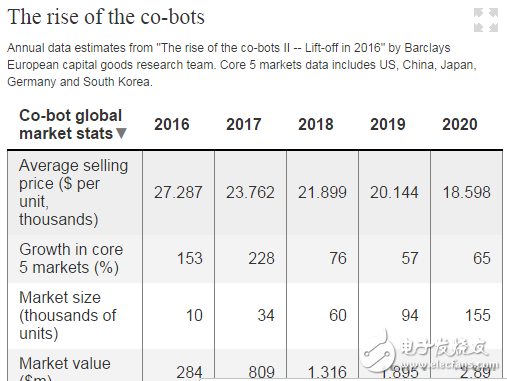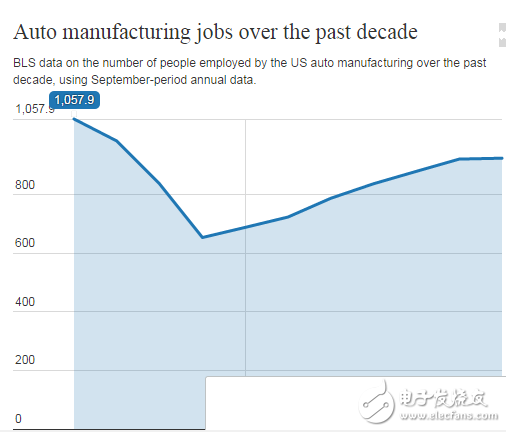According to CNBC, in the Ford Motor Company's plant in Cologne, Germany, a new robot was used on the assembly line to help make the Fiesta series more efficient. But these so-called co-bots are not meant to replace human workers, but work side by side with 4,000 workers in the factory and are not manipulated by humans.
Bruce Hettle, Ford's vice president of production and labor affairs, said: "By using collaborative robots to do more simple and labor, human workers have
To be liberated, it can make a greater contribution to the factory. Human employees can be more creative and help push us to the next stage. â€
For decades, the automotive industry has been a pioneer in the use of robots in factories, and this trend continues today. According to the Robotics Industry Association, North American auto companies spent $282 million in robotics in 2016, compared with just $436 million in years. These robots are traditional industrial robots that are so large that they can easily pose a threat to human workers. To this end, human workers need special protection when performing their duties.
Jay Baron, chief executive of the Automotive Research Center, said: “In modern assembly plants, up to 1000 robots can be found.†These machines can do a lot of things, such as welding doors, painting paint, loading engines, etc. . Barron said: "Without these automation equipment, our factory may have been eliminated very early. To ensure safety, quality and productivity, automation is essential."
The next era of robots
According to data released by logistics system integrator BasTIan SoluTIons, since 2010, due to the use of industrial robots, US car production has increased at an average rate of about 16% per year. A recent analysis of the use of industrial robots in the UK and US manufacturing over the past 14 years shows that labor productivity is increasing every year.
But recently, car companies are changing their strategies. Companies such as GM, Mercedes-Benz, BMW and Ford have experimented with or have begun using collaborative robots. Unlike the cumbersome industrial robots, the collaborative robots are smaller, such as the arm robots produced by KukaRoboTIcs in Germany or the Baxter robots from Boston Rethink RoboTIcs. Sometimes they are less than 1 meter tall. They are designed to work side by side with humans rather than being manipulated by humans.
At Ford's German plant, Kuka Robotics' robots are installed on two workstations, and the collaborative robots help workers install shock absorbers on the car wheel arches of the Carnival. This is just a microcosm of the more use of robots by car companies, they can also be used to perform various tasks such as material handling or welding. These machine workers help humans to liberate in order to think about how to provide personalized and customized services, as more and more customers demand customized services.
Frank Tobe, publisher and robot expert at The Robot Report, said: "This is not only related to the use of collaborative robots, but also to the reduction in the number of industrial robots. Traditional industrial robots in automakers are becoming obsolete because Every car is becoming different."
As consumers become more personalized and customized, they are becoming more and more difficult for large industrial robots to manufacture precision-configured vehicles. In this era of mass customization, industrial robots are difficult to adapt because they need to be constantly reprogrammed.
Analysts at the US investment bank Barkley predict that the collaborative robotics field will grow at a faster rate. In 2015, global collaborative robot sales were $116 million. By 2020, Barkley expects global collaborative robot sales to reach $3 billion. Barclays Capital analyst James Stettler said: "Today, cars have become the largest terminal market for robots. In the future, the robotics market will become larger and larger."
The rise of collaborative robots

Automakers have become pioneers in the use of collaborative robots, and collaborative robots are more cost effective than industrial robots. Currently, the average selling price of collaborative robots is close to $30,000 and is expected to drop to $18,500 by 2020. Automakers also prefer the flexibility of collaborative robots, which do not need to be fixed at a certain location in the factory, so they can be moved in different parts of the factory. Toby said: "You can assign them to work in the morning, and at night you can arrange completely different tasks in different places."
According to the auto company, for human workers, collaborative robots are safer. The reason is that the cooperative robots are equipped with detectors that can detect organs such as fingers or palms. Some collaborative robots have deep learning capabilities even through artificial intelligence, which allows them to find their own tasks at work without prior programming.
Jeff Burnstein, president of the Robotics Industry Association in Michigan, said: "I believe that all automakers are looking to integrate collaborative robots into their factories because there are many potential benefits: they are low cost, Easy to set up and operate, less programming tasks, no need to take up too much space, safe collaboration with surrounding workers, etc."
Of course, collaborative robots are still in their infancy. Bernstein is optimistic that by 2020, the global market value of collaborative robots will reach $3 billion. He said: "Collaborative robotics are still emerging technologies. Whether they are suitable for a variety of applications, whether they are too slow or reliable, whether they become truly safe, etc., they still have many obstacles to overcome."
Manufacturing plant transformation
For the manufacturing industry, their biggest concern is that any kind of robot will replace many human jobs, as is the automotive industry. According to statistics from the Automotive Research Center, from 1985 to 2015, the hourly positions of Detroit's "Big Three" such as GM, Ford and Fiat-Chrysler have dropped from 600,000 to 137,000. According to the US Bureau of Labor Statistics, more than 307,000 jobs in the US auto manufacturing industry have disappeared since 2000.
Barron of the Automotive Research Center said: "You look at the factory floor and see the human figure almost. But this automation is not to replace human workers, but to meet the productivity and quality demands of today's manufacturing industry. â€

The National Association of Auto Workers has not responded to this. For car companies, collaborative robots, and humans, you need to find the right balance. Toby said: "The current robotics technology does not meet the level of flexibility that automakers need, and for this they are re-recruiting humans."
At Mercedes-Benz, robots have begun to be replaced by humans. The company claims that human flexibility is necessary as the company moves toward customization and offers more choices for users, such as heating or cooling the cup holder. In many factories in Japan, Toyota is also replacing industrial robots with humans to ensure that factory workers are skilled employees and can find ways to make cars more efficient.
A study by the Massachusetts Institute of Technology at the BMW plant found that when humans and robots work together, they work 85% more efficiently than humans and robots. Human work replaced by collaborative robots is a repetitive and dangerous job, and human workers will have more time to focus on other jobs. Toby said: "Some tasks, if done by humans, may reduce productivity. Collaborative robots allow humans to program machines and do what they don't want to do."
Today, Ford does not have any collaborative robots in the United States. But a company spokesperson said they are preparing to introduce collaborative robots in their global factories. There will be more and more collaborative robots, but newer human employees will be more and more, whether they work side by side with collaborative robots in the factory. Ford said the company has added 28,000 jobs in the past five years. Ford's Hertel said: "We don't think more robots mean layoffs. We think that humans should work side by side with robots." (Little)
Home Appliance Voltage Protector
Household Smart Voltage Protector,Household 5A-15A Voltage Protector,Household 15A Power Voltage Protector,Household Universal Socket 30A Voltage Protector
Yuyao Huijun Electrical Appliance Co., Ltd. , https://www.yyhjdq.com